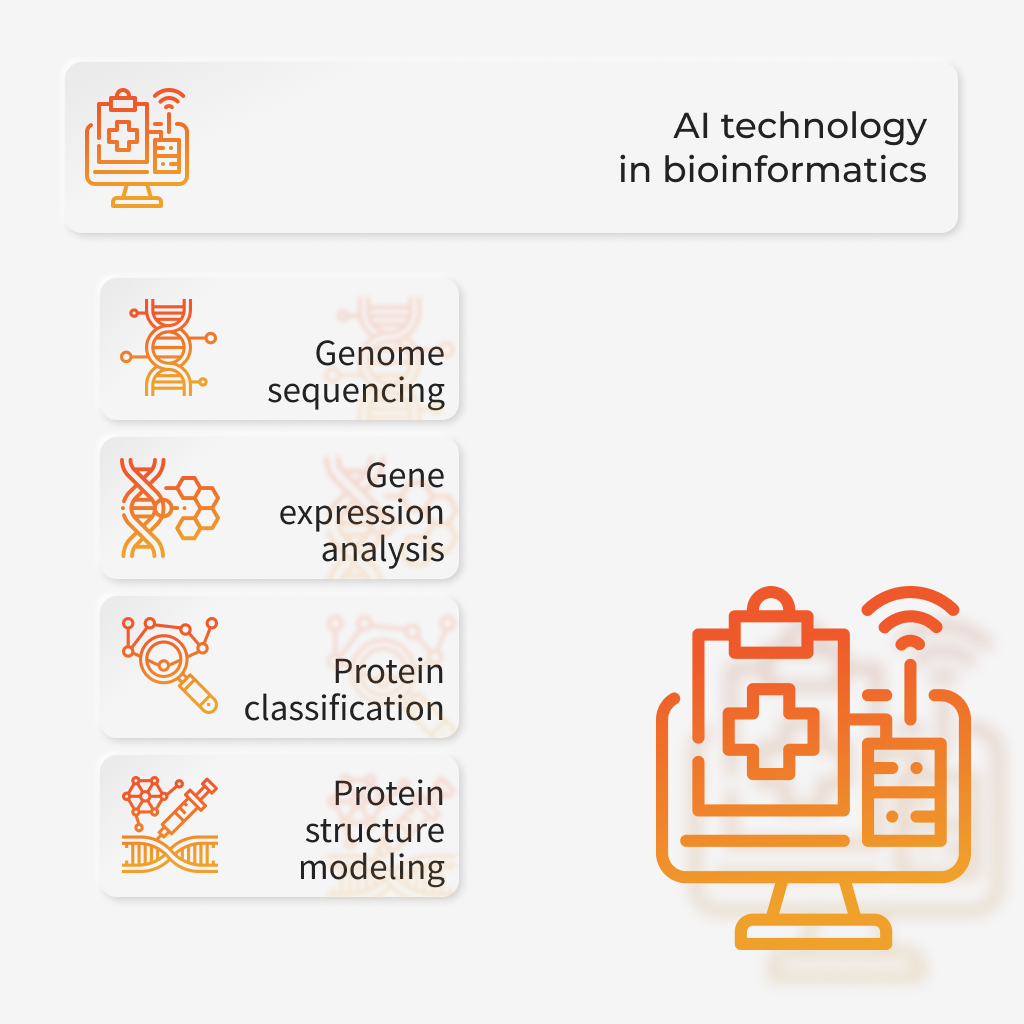The use of AI in bioinformatics has proved to be highly beneficial in managing and analyzing biological data. The merging of bioinformatics and AI analytics can be utilized for DNA sequencing, protein classification, and generative modeling for protein structure.
Today, bioinformatics is defined as a field of hybrid science that uses computation to extract insights from biological data. But historically, it did not mean what it means today. The term was coined in the 1970s and referred to the study of informatics process in biotic systems. But now, it is an interdisciplinary field that involves the study of molecular biology and genetics, mathematics, computer science, and statistics. It helps solve large-scale and data-intensive biology problems from a computational point of view. It amalgamates techniques to collect, store, distribute, and analyze biological information to support scientific research in multiple areas of biology. And what better than AI algorithms to analyze data. One of the reasons for the traction that AI is gaining is its ability to detect patterns based on large datasets and then make predictions from those patterns. This ability has paved the way for many applications of AI in bioinformatics.
Applications of AI in bioinformatics
Bioinformatics applications are majorly software tools that help to generate and store useful biological knowledge. But, bioinformatics tools embedded with AI technology can help generate that information much quicker and also help to make predictions from that. AI bioinformatics tools facilitate creations of advanced methods for biological sequence comparison, knowledge management, and protein-protein interaction.

Genome sequencing
The DNA structure is a helix formed by four building blocks called Adenine “A,” Thymine “T,” Cytosine “C,” Guanine “G.” These blocks form pairs to create a functional molecule called a gene. Gene finding is a process that consists of a combination of extrinsic and intrinsic searches. As an extrinsic search, a target genome is searched for sequences that are similar to extrinsic evidence. Extrinsic evidence is in the form of known gene sequences that are previously discovered and labeled. As an intrinsic search, prediction algorithms try to identify segments of DNA that can host gene sequencing. Currently, there are many ML algorithms and deep learning networks that are being deployed for an intrinsic search like Multilayer Perceptron, K-Nearest Neighbor, and Random Forest.
The use of AI algorithms enhances the speed of finding the host gene, which further enhances the sequencing process that can help get an accurate gene structure to provide personalized and life-saving therapies to patients. For instance, ML algorithms can find patterns from historical DNA datasets and then predict the odds of an individual developing a disease according to his or her genome sequencing. All these medications done with the help of genome sequencing commences by analyzing gene expressions.
Gene expression analysis
DNA microarray is a chip that has a collection of DNA spots attached to it. Researchers use microarrays to collect and measure gene expressions in organisms. Gene expression is converting the information extracted from a gene and using it to create a functional gene product like protein. Machine learning can analyze, identify, and classify patterns in gene expressions. Microarrays and machine learning techniques, when combined together, can help detect tumor cells at a molecular level. This will enable doctors to provide personalized cancer treatments to patients based on the genetic build-up of a tumor.
The disease is not a one size fits all, it’s unique, and the answer to what disease a person is suffering from is in the DNA. Let’s take the example of cancer. Analyzing cancer gene expressions and matching them with other gene expressions that are not affected help doctors to find the differences in both gene structures, which helps them to identify cancer drivers. Analyzing gene expression helps to find a medicine that can help fight unique cancer drivers for a patient or medicine for another type of cancer but driven by similar types of cancer drivers. Although genome sequencing and analyzing gene expressions can be done without AI, but the use of AI can enhance the sequencing speed. For instance, the first reference genome sequence was completed in 2003 and it took 13 years to achieve this feat. But now, with the help of AI, genetic diagnostics and sequencing can be done in a single day.
Protein classification
Proteins are the basic components of a living organism that enables life. They are the reasons behind diverse functions within organisms like responding to stimuli, structuring cells, metabolic functions, and others. Classification of protein patterns across human cells is usually done by humans on the basis of their structure. But with recent advancements in microscopy throughputs, cellular images are created at high space, and classification of proteins manually has become challenging. Computer vision can gain understanding from these cellular images that can be used by ML algorithms to classify proteins.
Protein classification helps researchers to predict the bonding of various molecules. Based on the classification of proteins, ML algorithms can help detect how a protein will bond with different drugs. And how protein bonds with drugs can affect the efficacy of a drug. The less bound a drug is with the cell’s protein, the more efficiently it can traverse through the cell membrane. Thus, protein bonding with drugs can help determine what medication can solve a specific disease for a particular person. AI can also help in predicting protein structure. A protein’s structure can be divided into four layers: primary, secondary, tertiary, and quaternary. Protein structure prediction is a process that helps to predict a protein’s structure from its first layer. AI algorithms help to accurately and quickly predict how protein layers will fold, thus identifying the structure of a protein.
Protein structure prediction is beneficial in pharmacy to design a drug and its bonding with proteins of consumers’ bodies. It is also helpful in biotechnology for designing novel enzymes.
Protein structure generative modeling
Generative models can generate new data instances that can be used to train AI algorithms for various fields of bioinformatics. These models aim to learn data representation and creates new data instances that look similar to the original one. One of the efficient approaches to create generative models is Generative Adversarial Networks (GANs) that are types of neural networks and uses a generator and a discriminator network for generating protein structures. The generator network tries to generate a natural image, whereas the discriminator tries to determine whether the image generated by the former network is fake or real. And then, the images that are determined as real can be used to train AI algorithms.
While the impact of AI in bioinformatics is fascinating, it needs more data to improve. And that will be possible with the sequencing of more patients. Yes, you heard it right, since bioinformatics is collecting data, every patient is a source data himself. And, once AI systems have data, there are various ways to turn this data into insights and using them for various benefits. The combination of bioinformatics and AI technology will play a significant role in streamlining complex analytical workflows into one single analysis framework. And, such frameworks will enable processing and analyzing biological data at unprecedented rates. It can surely be said that the future of bioinformatics lies in analyzing a tremendous amount of data with AI algorithms to provide huge savings in time and money, which will further accelerate biological research.




